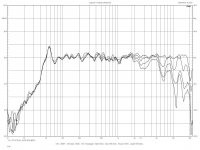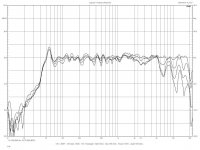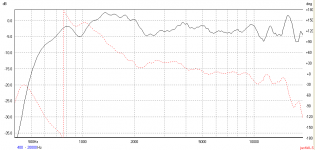Sorry Ro, not a member of that forum.
Ouch, forgot.
Here it is, in twofold:
Attachments
Here's a tread (in French > use google translate) in which the CP755Ti is compared to the Faital HF146 and HF144 in combination with 18Sound's XR1496 horn.
Last edited:
On the Lansing forum there's a ton of info to be found on the classic 4" drivers, as well as many experiments with diaphragms.
In conclusion: these are good up to about 9-10 kHz and (severely) compromised above.
I've no doubt, JBL is probably the most tweaked brand in the history of audio trying to get around the W.E./Lansing/Altec patents.
Yep, and technically this is pretty much the limit for this size without mods, which in the pioneer's case was the tangential surround where all the extreme HF is generated, so just mass quantities of break-up modes [noise/distortion] in reality that our internal processors [brain] somehow allows us to perceive it as 'euphonic'. Life truly can be stranger than fiction.
GM
Here is a comparison of HF200, HF204 and CP750ti: Driver comparison: Faital HF200, Faital HF204, Beyma CP750Ti at Jabo 72 horn - Technical/Modifications - The Klipsch Audio Community
Looks like the polymer diaphragm has the edge on the low end. There seems to be an issue between 2 and 3 kHz though, which can also be seen in the datasheet.
BTW, whats the difference between HF146 and HF146R?
That are quite specific to the requirements one might have. I could also say: why not use 8 Ohm? A class D amp can drive it easier, flattening impedance is mostly a non-issue with those anyway because of the ultra low output impedance, and efficiency matching can be done is software nowadays 😀
See.. same difference. One just has to choose whatever matches the situation.
Looks like the polymer diaphragm has the edge on the low end. There seems to be an issue between 2 and 3 kHz though, which can also be seen in the datasheet.
BTW, whats the difference between HF146 and HF146R?
But why not choose 16 ohm drivers?
This might be a better match with 15“ woofers in terms of efficiancy or usind a tube amp as horn amp (bi amping) or more options for flatening the impedance like paralell resistance.
That are quite specific to the requirements one might have. I could also say: why not use 8 Ohm? A class D amp can drive it easier, flattening impedance is mostly a non-issue with those anyway because of the ultra low output impedance, and efficiency matching can be done is software nowadays 😀
See.. same difference. One just has to choose whatever matches the situation.
Last edited:
just like the add, I'm very appreciative of the discussion and information being posted on this thread.
question: will a 1" to 1.4" adapter be very detrimental to the sq?
You're welcome!
IME, adapters deteriorate the extreme HF too much, or so my then youthful, bat eared girls told me, so wound up truing up mating surfaces, using wax paper gaskets and align honing the whole assembly with a three stone brake master cylinder hone before all was well with them.
The downside is you have to disassemble the driver to hone this joint where the > ~3.5-5 kHz BW is [depending on driver design], so not a tweak for the casual DIYer. Still, using the hone to do minor smoothing at the adapter throat and proper honing at the horn throat joint is easy enough to do, just don't forget to permanently index the assembly.
GM
An adapter could be made to have no detrimental effects. An adapter chosen at random could be analysed as to why it may have detrimental effects in a specific case.
Agreed, I just responded to the mass market kind like shown since I'd gotten carried away with one pair.
GM
GM
Yes. I'm wondering about the sudden rise in distortion at 1Khz. You see that with almost all of measured drivers over there. I think it's a measurement issue. To bad that they did not measure distortion below 1Khz 🙁
An adapter could be made to have no detrimental effects. An adapter chosen at random could be analysed as to why it may have detrimental effects in a specific case.
If you look at the MRII 564 Datasheet, specifically the drawing, you'll notice it's a rather deep horn (31cm). This depth was necessary for the desired loading to ca. 500Hz.
I expect the throat entrance was designed for the 288 driver.
Now you could use a 1" adapter, but you'll likely end up with a total horn depth of about 35cm, or a kind of trumpet.
BTW, whats the difference between HF146 and HF146R?
"Similar to FaitalPRO's HF146, the HF146R has a slightly longer voice coil winding depth to provide lower power compression and better dynamics when pushed to its limit."
Just a glimpse at the diaphragm suffices.
Eegad! The ultimate euphonic distortion generator! Guess it's really true then that if we can't be dazzled enough with brilliance, then we can be baffled enough with BS [distortion in this case]! 🙁
Wow! Oh well, as long as it sounds 'real', don't care how its done; still a sad commentary though on how crude/limited human hearing is without an incredible processor to decode it.
GM
If you want my personal opinion; I think excessive emphasis is often placed on the top end (15-20kHz), whereas the soul, or heart of the music,
namely the midrange, seems to be neglected.
1.4" drivers offer the best of both 1 and 2" (exit) worlds.
They usually allow crossover points as low as 700Hz (or lower) and are capable of clean output up to 15kHz.
Agreed, I learned the hard way with my 'adventures' in adapter applications that if you want both lows and highs out of one horn, then dual drivers is required, so went with dual 1" in a 1.5 way system, which sums to a bit larger Sd than a 1.4" to easily load to 500 Hz/prosound and 250 Hz/HIFI-HT.
Ideally this would need the pioneer's phenolic diaphragm for the '.5' driver to add a bit more perceived 'body' to the vocals, though nowadays it would be much better overall to build a simpler, cheaper Synergy concept horn system.
GM
Yes. I'm wondering about the sudden rise in distortion at 1Khz. You see that with almost all of measured drivers over there. I think it's a measurement issue. To bad that they did not measure distortion below 1Khz 🙁
This seems typical for Listen SoundCheck distortion measurements, depending on the driver and chosen algorithm.
Last edited:
Ro808 and GM Have been consistent, for sure....I initially thought GM was a forum moderator ��
Beyma response curves are some of the most true to life representations I’ve come across. I was able to find community taken measurements to confirm that, I don’t think I can say the same for a lot of other big names.
Beyma response curves are some of the most true to life representations I’ve come across. I was able to find community taken measurements to confirm that, I don’t think I can say the same for a lot of other big names.
- Home
- Loudspeakers
- Multi-Way
- Is it possible to cover the whole spectrum, high SPL, low distortion with a 2-way?





